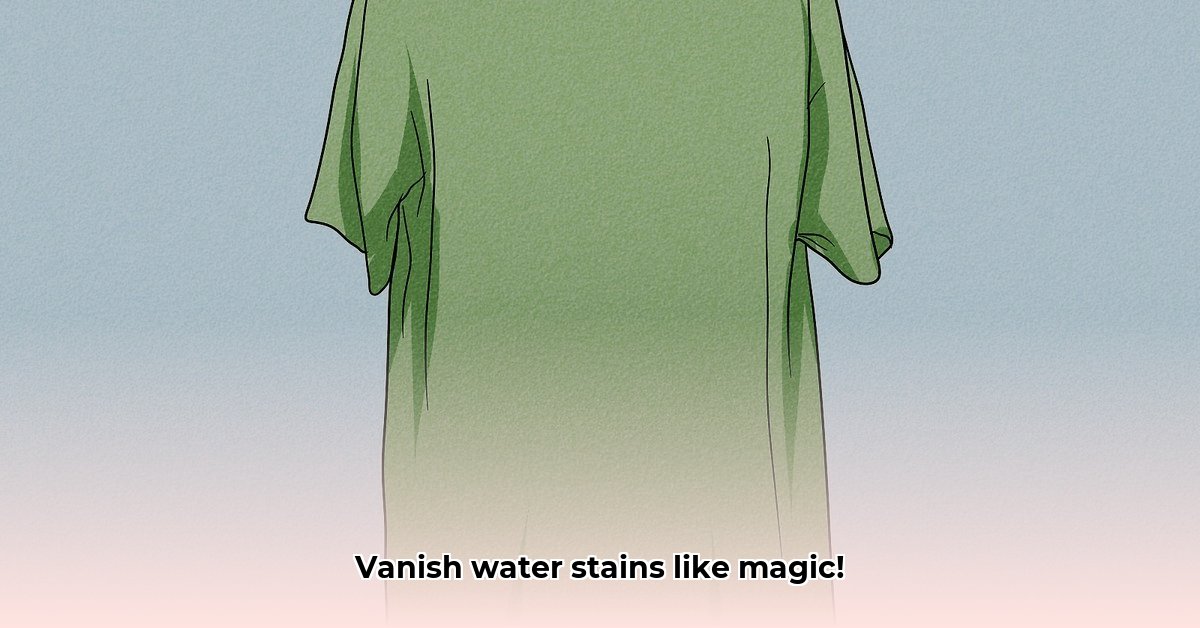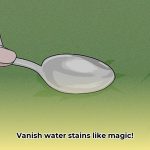Uh-oh, water stains! Whether it’s a ring on your shirt or a splotch on the couch, they’re never fun. But don’t worry, this guide will help you banish those pesky marks. We’ll walk you through simple DIY tricks for fresh spills and stubborn stains, no matter the fabric. Ready to get started?
Banishing Water Stains: Quick Fixes & Proven Methods
Understanding Water Stains
Those annoying rings or faded spots that appear after a splash are water stains, often caused by minerals left behind as water dries. Even plain water can leave marks, especially on delicate materials, like silk or wool. Understanding the cause helps determine the best removal method.
Act Fast: First Aid for Spills
Time is of the essence with fresh spills. Gently blot (don’t rub!) the excess liquid with a clean, absorbent cloth. Rubbing can spread the stain and damage fibers. Never put a stained item in the dryer before treating it – heat sets stains, making them much harder to remove.
Rescuing Washable Fabrics
Ironing Out Water Stains
For iron-safe fabrics like cotton, linen, and polyester:
- Place a clean, white towel on your ironing board to prevent color transfer.
- Place the garment face down on the towel, with the stain against it.
- Lightly dampen the stain with distilled water (tap water may contain minerals).
- Iron over the damp area using the appropriate heat setting, keeping the iron moving.
- Repeat if necessary. For stubborn rings, gently rub with the back of a spoon or your fingers after rinsing under hot water.
Washing Machine Magic
For most washable fabrics:
- Pretreat the stain with gentle laundry detergent.
- Wash according to the care label.
- If you have hard water, add extra detergent or a water softener.
- Avoid bleach unless the stain is discolored, as it can worsen some water marks.
Hand Washing Delicates
For delicates like silk and lace:
- Use mild detergent and lukewarm water.
- Gently rub the stained area with your fingers.
- Rinse thoroughly with cool water.
- Add a splash of distilled white vinegar to the final rinse.
- Air dry flat.
Steam Power
Steam cleaning is effective for many fabrics, but avoid suede, waxed jackets, or plastic (it could melt!).
- Steam the stained area from both sides, top to bottom.
- Let it air dry completely.
Conquering Upholstery & Carpet Stains
Vinegar Solution
- Mix equal parts distilled white vinegar and water (test a weaker solution on upholstery first).
- Always test in an inconspicuous area.
- Lightly spray or dab the solution onto the stain.
- Gently rub with a clean cloth.
- Blot dry and repeat if needed.
- Dry completely with a hairdryer (cool setting) or a fan.
- Vacuum carpets afterward.
Expert Advice: Cheryl Mendelson’s Tips
For fresh spills, flush with cool water, rub in detergent, soak for up to an hour, then wash. For set-in stains, try a paste of enzyme pre-soak and water, applied thickly and covered with a damp cloth overnight before washing.
Preventing Water Stains
Prevention is key! Use coasters, placemats, and clean upholstery/carpets regularly. A water softener can help if you have hard water.
The Science of Water Stains
Water stains are caused by dissolved minerals (like calcium and magnesium) in hard water. These minerals are left behind when water evaporates, creating those whitish or brownish rings. Absorbent fabrics (silk, wool, upholstery) and darker colors show stains more readily. Dirt, oils, and detergent residue can also contribute. Quick action is crucial for removal. Ongoing research suggests new prevention and removal methods may emerge.
Identifying Water Stains: A Detective’s Guide
Recognizing water stains isn’t always straightforward. A “water stain” might involve other substances, like sugar or minerals from hard water. Consider the source of the liquid. Plain water leaves a lighter mark, while hard water leaves a whitish ring. Sugary drinks or other substances can cause sticky, discolored stains. The fabric type is crucial for choosing the right cleaning approach.
Here’s a quick guide for common fabrics:
| Fabric | Cleaning Method |
|---|---|
| Cotton | Vinegar and water solution, blotting |
| Linen | Dish soap and water, dabbing gently |
| Wool | Diluted vinegar, dabbing carefully |
| Silk | Mild dish soap and water, blotting with a damp cloth |
| Synthetics | Test commercial stain remover in a hidden area first, follow product instructions |
For stubborn stains, steam cleaning can be effective (if the fabric allows). For delicate or valuable items, consult a professional cleaner. Prevention is best: use fabric protectors, blot spills immediately, and monitor humidity.
Removing Fresh Water Stains: DIY Methods
Fresh stains are easier to remove. Act quickly!
Vinegar: Nature’s Stain Remover
White vinegar is a potent, natural stain fighter. Mix equal parts white vinegar and cool water. Dampen a clean cloth and gently blot the stain. Rinse with cool water and air dry.
Dish Soap: Gentle Cleaning Power
For delicates, use a few drops of mild dish soap mixed with water. Gently dab, blot, and air dry.
Baking Soda: The Absorbent Champion
For tougher stains on washable fabrics, sponge with the vinegar/water mixture, then sprinkle baking soda on top. Let it sit, vacuum, and launder.
Fabric-Specific Approaches
| Fabric | Recommended Method |
|---|---|
| Cotton | Vinegar and water |
| Linen | Mild dish soap and water |
| Wool | Diluted vinegar |
| Silk | Mild dish soap and water |
| Synthetics | Test a small area first |
Prevention: Your Best Strategy
Prevent stains by using coasters, wiping spills immediately, and being mindful of water sources. Always test cleaning solutions on an inconspicuous area first.
Tackling Stubborn, Set-in Stains: Advanced Techniques
Set-in stains are remnants of minerals that have solidified on fabric fibers. Patience and persistence are key.
Distilled Water: Purity for Recent Stains
Distilled water, free of minerals, can dissolve fresh mineral traces. Dampen a white cloth and blot.
Vinegar’s Power: Dissolving Mineral Bonds
For older stains, mix equal parts white vinegar and distilled water. Blot from the outside in.
Steam: Gentle Persuasion
For delicates, hold a steaming iron or kettle a few inches above the fabric. The steam loosens mineral bonds, allowing you to blot the stain away.
Baking Soda Paste: Drawing Out the Stain
Make a paste of baking soda and water. Apply, let dry, and brush away.
Fabric-Specific Strategies
| Fabric | Recommended Method(s) | Why it Works |
|---|---|---|
| Cotton/Polyester | Distilled water, mild detergent, vinegar solution | Durable fabrics handle more aggressive treatments. |
| Silk/Wool | Steam, diluted white vinegar | Delicate fibers need gentle methods. |
| Upholstery | Vinegar, baking soda paste, steam (test first) | Consider fabric type and colorfastness. |
| Velvet/Suede | Professional cleaning, dry brush, careful misting | These fabrics damage easily and need specialized care. |
Prevention: The Ultimate Solution
Use fabric protectors, especially on upholstery, and blot spills immediately.
Troubleshooting
For persistent stains, repeat the chosen method or consult a professional cleaner. Not all stains are entirely removable. For valuable items, professional help is recommended.
- How to Remove Water Stains from Fabric: A Complete Guide - April 26, 2025
- How to Get Motor Oil Out of Clothes: Proven Methods & Expert Tips - April 26, 2025
- How to Get Deodorant Out of Black Shirts: Easy Stain Removal Guide - April 26, 2025










